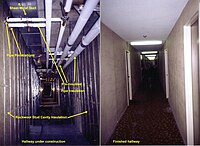
Photo from wikipedia
Abstract For reducing the energy use of buildings, the application of insulation materials can be a possible solution to improve energy efficiency. However, with the continuously tightening regulations, thicker and… Click to show full abstract
Abstract For reducing the energy use of buildings, the application of insulation materials can be a possible solution to improve energy efficiency. However, with the continuously tightening regulations, thicker and thicker insulations should be used (e.g., up to 20–25 cm in Hungary and about 40–50 cm in the Nordic countries) to fulfil the directives. In the past decades, developmental research started to focus on both decreasing the thickness and decreasing the thermal conductivity of materials parallels. With this research direction, the investigations of the new type of insulation materials took place. The use of materials having thermal conductivity with less than 0.020 W/mK spread over. These materials are the so-called super insulation materials. Besides Vacuum Insulation Panels (VIPs), aerogel-based materials belong to this group, too. This paper will present laboratory tests executed on two altered types of protected Vacuum Insulation Panels: a one side and a 2 side protected VIP, also called Vacuum Insulation Sandwich (VIS). The first one, type “A” contains 20 mm thick laminated fumed silica, covered with 10 mm thick expanded polystyrene on one side, while type “B” was the one where the 10 mm thick laminated fumed silica core was packed between two 10 mm thick EPS slabs. Firstly, thermal insulation performance was investigated by the so-called guarded hot-box method for U-value, where the samples were placed on a solid brick wall. Furthermore, the thermal insulation performance of protected VIPs was also tested with Hukseflux heat flux plates. To reveal the applicability limits caused by the thermal bridges infrared thermography images (IR) were taken, too. From the images and the measurement results, a theory was formed regarding the heat flow directions inside the encapsulated panels. The current article emphasizes the equivalent thermal conductivity for the assessment of the thermal protection performance of vacuum insulation panels. The paper states that by using VIPs at least, 70% reduction can be reached in the U-value compared to the value of the solid brick wall. Moreover, the paper points out that the use of EPS protection layer on both sides of the VIP has a promising effect by reducing the thermal bridges. Furthermore, the VIP protected with EPS slabs on both sides results in less equivalent thermal conductivity.
Journal Title: Energy and Buildings
Year Published: 2021
Link to full text (if available)
Share on Social Media: Sign Up to like & get
recommendations!